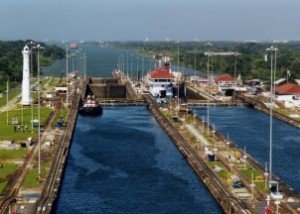
(World Crunch) Throughout the history of the United States, the main divisions have traditionally been between the North and the South, an economic and political rivalry that we know also produced a civil war.
But there is also an important rivalry between the West Coast and the East Coast, a battle for cultural, academic and scientific supremacy, an ongoing contest to attract the best musicians, artists and chefs.
This rivalry now has a new feature, as the East Coast prepares to compete with the West Coast for the lucrative shipping lines coming from Asia. The reason for this? The expected expansion of the Panama Canal, a project that could end up tipping the balance of power toward one coast over the other.
The expansion, at a cost of more than $5 billion, has the directors of ports on the Gulf of Mexico and the East Coast opening bottles of champagne. They have reason to expect huge profits if they manage to get large cargo ships – which previously had to port on the Pacific Coast because of the Canal’s limitations – to finally sail into their ports.
The Port of Miami, which has already managed to exploit its geographic position and call itself the bridge to the Americas, is preparing to take advantage of this new opportunity and has invested more than $2 billion in infrastructure upgrades.
“My friends, we will be ready to take advantage of the opportunities brought by increased traffic from Asia, as the first stop-over port for containers, both incoming and outgoing,” said the Port of Miami’s director, Bill Johnson, in the port’s annual report.
In a little more than two years, a wider and deeper Panama Canal will give shipping companies less expensive options for shipping to ports on the East Coast. “Full speed ahead, to the Port of Miami,” says Johnson.
For the port, preparations for the canal’s widening have been the most ambitious investment project in its history. Once they are completed, they will allow the port to receive large ships like the so-called “Post Panamax” size ships, which could not fit into the canal and had to stop in California.
Tens of thousands of new jobs
“When the Panama Canal permits better access to the routes from Asia to the East Coast of the U.S., we will all benefit. We are hoping to increase our capacity,” explained the port’s sub-director, Juan Kuryla.
But the positive consequences of the Panama Canal expansion are not limited to Miami. The whole state of Florida is expected to benefit, and estimates from different sources say the state will add more than 30,000 new jobs.
According to the Port of Miami, the expansion in the Panama Canal will allow it to double its capacity in the next seven or eight years. However, all of this will require certain reforms.
As part of the preparations to increase its capacity, the Port of Miami has already started a number of projects that include the construction of a tunnel that will connect the port with the highway, without stopping at a single stoplight. According to Kurlya, this direct access should be ready at the beginning of 2014, a year before the expansion of the canal is finished.
Another project is the deepening of the port itself, to a depth of 15.2 meters. This will allow it to be the only port south of Virginia to have that kind of depth. In addition, the Port is acquiring four “Super Post Panamax” cranes, which will make the transport of major maritime cargo possible. And they are building a special railroad to facilitate moving cargo by rail.
It seems like the West Coast has reason to worry. “If I were running a port on the West Coast, I would be on the alert, because the expansion of the canal is going to benefit the Port of Miami and other ports on this coast,” said Kuryla.
California is prepared to do battle to prevent the loss of large cargo carriers to the Gulf Coast and the East Coast. That’s why it has launched an aggressive campaign titled “Beat the Canal,” so that the whole industry will improve its competitiveness. It is preparing to take on the challenge presented by an enlarged canal and East Coast ports looking to steal business.
Read the article in the original language.
All rights reserved ©Worldcrunch – in partnership with AMERICA ECONOMIA